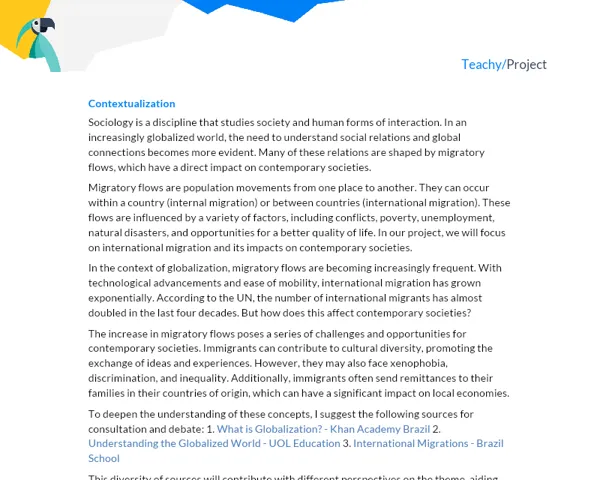Contextualization
Introduction
In the field of sociology, the concepts of rights and duties are fundamental to understanding the functioning of societies and the individuals that compose them. Rights represent the inalienable privileges that all human beings should possess, regardless of their origin, race, sex, religion, nationality, or any other discriminatory factor. These include civil, political, economic, social, and cultural rights, and are based on universal principles of freedom, equality, dignity, and respect.
On the other hand, duties refer to the obligations that each individual has towards society. These may include respect for laws and customs, contributing to the common good, and promoting and defending human rights. In general, rights and duties are intrinsically linked, as the guarantee of rights depends on the fulfillment of duties.
The third key idea of our project is that of territory, which involves the occupation, use, and organization of space by a certain group, state, or community. The formation of territories is related to geographical, economic, social, cultural, and political factors, and involves processes of border delimitation and identity definition.
Contextualization
In the contemporary world, understanding rights and duties is essential for promoting social justice and peaceful coexistence among different peoples and cultures. However, inequality in the guarantee of rights and the disregard for duties are persistent problems in many societies, leading to conflicts, injustices, and human rights violations.
Similarly, the occupation and transformation of space are continuous processes that occur in all societies and have a direct impact on people's lives. The way societies organize themselves in space and define their territories reveals much about their ways of life, power relations, and cultural values. Therefore, analyzing the processes of territory formation can contribute to understanding the social, economic, and political dynamics of a society.
Practical Activity
Activity Title: Rights, Duties, and Territory: a Nations Simulation
Project Objective:
The objective of this project is to allow students to understand the concepts of rights, duties, and territory through the simulation of nation formation. Students should explore the connection between these concepts and apply their knowledge in a practical and engaging scenario.
Detailed Project Description:
In this project, students will be divided into groups of 3 to 5 members. Each group will represent a nation and will be responsible for defining the rights and duties of its citizens, as well as establishing its territory.
Students should first research the concepts of rights, duties, and territory, and how these are applied in different nations. Based on this information, each group should draft a Constitution for their nation, defining the rights and duties of citizens and the rules for the occupation and use of the territory.
The project should also involve the graphic representation of the territory, taking into account geographical, economic, cultural, and social aspects.
Throughout the project, groups will also have to deal with hypothetical situations that may arise in a nation, such as territorial conflicts, ethical issues, and human rights violations.
This is an interdisciplinary project, mainly involving sociology, but also geography, history, and ethics.
Required Materials:
- Books and research websites on rights, duties, and territory
- Materials for creating the Constitution (paper, pens, computer)
- Materials for the graphic representation of the territory (paper, colored pencils, pens, design software)
Detailed Step-by-Step:
-
Group formation and nation definition: Each group will invent the name for their nation and define the basic characteristics of its population and culture.
-
Study of concepts: Groups must investigate and study the concepts of rights, duties, and territory, using the suggested references and other materials of their choice.
-
Constitution drafting: Based on the research conducted, each group must draft the Constitution of their nation, defining the rights and duties of citizens and the laws regarding the territory.
-
Graphic representation of the territory: Groups must create a visual representation of their nation's territory, including geographical aspects, infrastructure, and population distribution.
-
Simulation of situations: Groups will face different hypothetical situations, having to apply their knowledge of rights, duties, and territory to solve the problems.
-
Discussion and reflection: At the end of the project, groups should discuss and reflect on their experiences and the lessons learned, as well as evaluate the success of their nations.
In addition to the practical activities, each group must write a detailed report on the project, with sections for introduction, development, conclusion, and bibliography. This document should detail the process of studying and applying the concepts, the drafting of the Constitution, the representation of the territory, and the handling of hypothetical situations, as well as discuss the conclusions and lessons learned. The bibliography should include all sources used for the research and study of the concepts.

